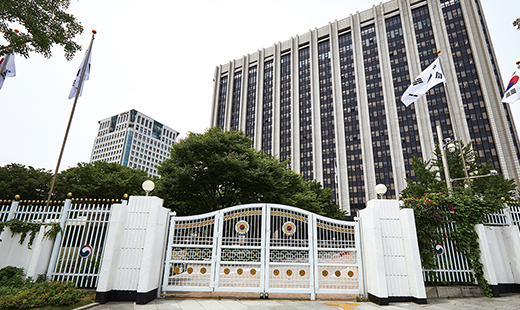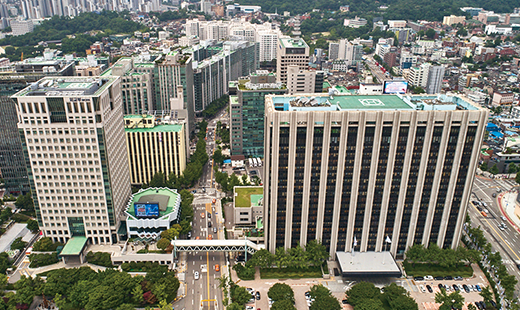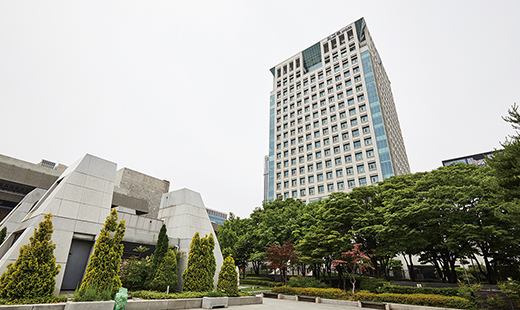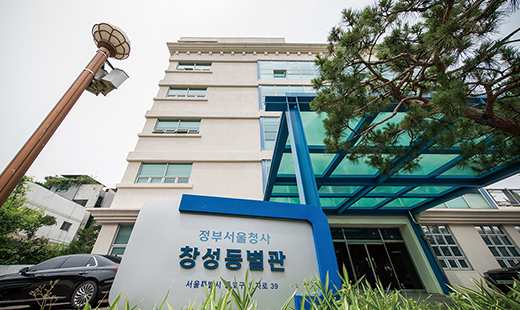Ministry of the Interior and Safety Government Buildings Management Office
검색창
SITE MAP
전체메뉴 닫힘Introduction
- HOME
- Government Complex Seoul
- Introduction
The Government Complex Seoul is the first government complex in Korea built to improve administrative efficiency and public service and to solve problems such as lack of space in the government building due to the expansion of administrative organizations and an increase in maintenance budget due to aging. The former central administrative agency had used the Central Office Building -- which was demolished in 1996 -- since the establishment of the Republic of Korea in 1948. As the scale of the government continues to expand, the lack of office space became so serious that several ministries had to use leased buildings. In terms of administrative efficiency, the need for new government buildings was also raised; in 1966, the site for the Government Complex, which is currently the main building of the Government Complex Seoul, was decided followed by a plan for the construction.
When deciding the location, accessibility to the central office was the primary factor to consider in addition to the historical significance as the area used to be Yookcho main street during the Joseon dynasty. The construction, based on a design with various new construction methods of the time applied, was started in July 1967 and completed in December 1970.
The Changseong-dong Annex was purchased by the Ministry of Government Administration in October 1981 in an effort to secure office space as the administrative organization further expanded with the diversification of the government and was renovated in 2005. Since 2018, the reconstruction of the annex has been discussed to enhance its seismic performance.
The annex of the Government Complex Seoul is a highly specialized office for foreign affairs -- befitting Korea’s stature as an OECD member country -- and was built to address the shortage of office space and parking problems in the Government Complex Seoul. The construction of the annex was promoted in 1989, commenced in March 1998, and completed in November 2002. The annex of the Government Complex Seoul is suitable for the country's foreign affairs business with special facilities such as international conference halls, foreign correspondents’ rooms, and treaty room.
Overview
- Location
- 209, Sejong-daero, Jongno-gu, Seoul
- Site area
- 18,582㎡
- Building size
- 3 basement levels and 19 ground levels
- Floor area
- 78,477㎡
- Structure
- Reinforced concrete and steel
- Construction period
- July 29, 1967 to December 23, 1970
- Total cost
- 4.7 billion won
Facility features
- KS 1004 (facility management) service certification (in 2017)
- Seismic design that can withstand a magnitude 6-7 earthquake (both main bldg. and annex)
Previous Names of Government Complex Seoul
- 1970Named “General Government Building” when it was completed.
- 1982Renamed “Government Building No. 1” considering the new government building being built in Gwacheon.
- 1997Renamed “Sejongno Government Building” ahead of the completion of the new government building in Daejeon.
- 1999Renamed “Central Government Building” based on a survey among public officials and visitors.
- 2012Renamed “Government Complex Seoul” in accordance with the Government Complex Sejong
Features of Government Complex Seoul
New construction methods
Foundation work
Steep slopes running north to south were completely leveled for the foundation work using the Caisson method, which integrates the bedrock and the foundation by filling the inside of the caisson that had landed on the underground bedrock with concrete.
Pillar
A bearing wall structure without pillars and a U-shaped layout along the wall were applied to make the most of the indoor space.
Frame
The slip form method, which pours concrete while raising a 1-meter mold by 10cm per hour, was used for the first time in Korea.
Plane
The core system -- which pursues efficient use of space by separating and condensing the service area of each floor from the office space -- was used as well as portable lightweight partitions to provide fluidity.
Equipment
Disaster prevention equipment, such as fire detectors and alarms, and central monitoring and control system (monitors, data loggers, digital indicators, etc.) that efficiently operate various facilities are installed.
The largest building in Korea
The General Government Building -- currently the Government Complex Seoul -- was the largest single building in Korea at the time of construction with site area of 15,600 and floor area of 70,473㎡. It has 3 stories underground, 19 stories aboveground, and 3 stories above the tower.
Open Communication Forum
Open Communication Forum Established to serve as a communication space where citizens and the government can meet to discuss policies.
Located on the first floor of the Government Complex Seoul Bldg. 6 (General Information Bldg.). Visit Gwanghwamun, 1st Street, website to sign up to use the space.




